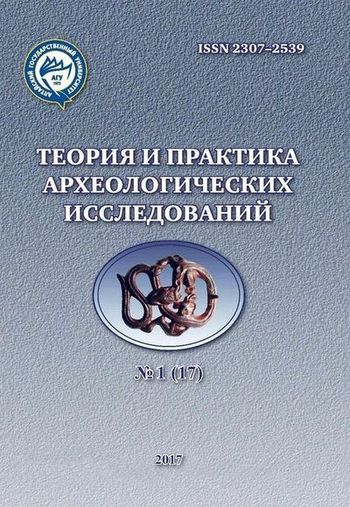METALLIC ARTIFACTS OF ARJAN-MAYEMIR PERIOD FROM THE ALTAI TERRITORY: X-RAY FLUORESCENCE ANALYSIS, CULTURAL AND CHRONOLOGICAL ATTRIBUTION
Abstract
At present, the Russian archaeologists’ task is a more intensive study of the materials that have been accumulated earlier. Modern methods of natural science are used to achieve this objective. These methods are intended to provide the necessary volume of objective information to verify the earlier conclusions, concepts and assumptions, as well as to reach a new level of research activity. The determining of the chemical composition of metal finds is particularly important in this process. The data acquired from the field where the work has not been carried out at all or it has been accomplished fragmentally are of remarkable value. The author of the article scheduled and sequentially executed the program of study of Arjan-mayemir archaeological finds (end of IX – 2–3 quarters of the VI century BC.) that have been studied with the help of X-ray fluorescence spectrometer SERIESTM ALPHA Alpha-2000 (USA), which is available at the Department of archeology, ethnography and museology of the Altai State University. Published results are based on research, which was based on archaeological finds stored in the Museum of Archaeology and Ethnography of the Altai State University (Barnaul). The most representative is the collection obtained during the excavation of the monument Elekmonar-II. Moreover the ancient objects of archaeological sites such as Bijkye, Boytygem-II and Tytkesken-VI were also involved. All of them show different stages of development of Biyken archaeological culture. An incomplete set of elements of horse equipment is used as a comparative material from the museum which reflects another tradition within the designated chronological period. Artifacts from location Gilevsky Bridge also refer to Mayemir (Mayemer) culture.
Downloads
Metrics
References
Abdulganeev M.T. Mayemir mounds of Boytygem // Archeology of the Altai Mountains. Barnaul : Publishing House of Alt. University Press, 1994. Pp. 37–43.
Borodayev V.B., Mamadakov Y.T. Burial Kyrlyk-I and-II Kyrlyk in the Altai // Mountains, Problems of archaeological sites in Siberia. Novosibirsk, 1985. Pp. 51–88.
Vasjutin A.S., Sadovoi A.N. On the problem of the reconstruction of traditional livelihood systems in the early Scythian time (Eastern Altai - burial Coo-I) // The results of the study of the Scythian period of Altai and adjacent territories. Barnaul : Publishing House of Alt. University Press, 1999. Pp 35–38.
Volkov V.V. Bronze and Early Iron Age in northern Mongolia. Ulaanbaatar : Shinzhleh Ukhaa Akademiiyn Hevlel, 1967. 148 p.
Volkov V.V. Deer stones Mongolia. Moscow : Scientific World, 2002. 248 p
Grishin Y.S. Bronze and Early Iron Age of Eastern Transbaikalia. Moscow : Nauka, 1975. 136 p.
Gryaznov M.P. The history of the ancient tribes of the Upper Ob from excavations near the village Big River. M..; L. : Publishing House of the USSR Academy of Sciences, 1956. 162 p.
Gryaznov M.P. Argens. Royal mound early Scythian time. L. : Nauka, 1980. 62 p.
Eurasia in the Scythian epoch: radiocarbon chronology and archaeological / A. Y. Alekseev, N.A. Bokovenko, V.A. Vassiliev et al. SPb . : Teza. 290 p.
Eniosova N.V., Saracheva T.G. Medieval jewelry craft in Europe: the main aspects in the history of the study // Antiquities of Eurasia. M., 1997. Pp. 286–316.
Zavituhina M.P. Mounds and village Bystrianskaya in the Altai Territory (Excavation SM Sergeev in 1930) // Archaeological collection of the State Hermitage. Vol. 8. L. ; M., 1966. Pp. 61–76.
Kadyrbaev M.K. Burial Zhilandy River Nura, back centuries. Almaty, 1974. Pp. 25–45.
Kearns T., Martinón-Torres M., Rehren T. Metal to mould: alloy identification in experimental casting moulds using XRF // Historical Metallurgy. 2010. №44(1). Pp. 48–58.
Kiriushin Y.F., Tishkin A.A. Scythian epoch of the Altai Mountains. Part I: Culture of the population in the early Scythian time. Barnaul: Publishing House of Alt. University Press, 1997. 232 p.
Kiriushin Y.F., Tishkin A.A., Matrenin S.S. Monument Scythian-Saka time Tytkesken-VI: the results of the study and cultural-historical analysis // «Terra Scythica». Novosibirsk, 2011. Pp. 97–116.
Kubarev V.D. Ancient statues of Altai (deer stones). - Novosibirsk: Nauka, 1979. 120 p.
Marsadolov L.S. Monuments of early nomads in Ust-Kuyume Altai (Excavation GP and GP Sosnowski Sergeyev) // Archaeological collection of the State Hermitage. Vol. 22. L., 1981. Pp. 11–22.
Marsadolov L.S. The main trends in the forms fished, Psalm and buckles horse in the Altai in VIII–V centuries BC // Outfit riding horse in the Altai region in the early Iron Age and the Middle Ages. Barnaul : Publishing House of Alt. University Press, 1998. Pp. 5–24.
Minasyan R.S. Methods for casting in bronze fished in Scythian and Scythian burial mounds time // Elite Eurasian steppes in the Scythian-Sarmatian period. SPb., 1994. Pp. 157–163.
Minzhulin A.I. Technology beading // SA. 1990. №4. Pp. 231–240.
Orfanou V., Rehren Th. A (not so) dangerous method: pXRF vs. EPMA-WDS analyses of copper-based artefacts // Archaeological and Anthropological Sciences. 2014. DOI 10.1007/s12520-014-0198-z
Savinov D.G. Deer stones in the culture of Eurasian nomads. SPb. : Publishing House, St. Petersburg. University Press, 1994. 208 p.
Semenov Vl.A. Synchronization and history monuments aldy-bielsko type in Tuva // Results of the study of the Scythian period of Altai and adjacent territories. Barnaul : Publishing House of Alt. University Press, 1999. Pp. 165–169.
Stepanova E.V. Evolution of the horse harness and the relative chronology of the monuments of the Pazyryk culture // Archaeological news. 2006. №13. Pp. 102–150.
Stepanova N.F. Burials in stone boxes and their dating // Burial rites of the ancient tribes of Altai. Barnaul : Publishing House of Alt. University Press, 1996. Pp. 54–69.
Steppe zone of the Asian part of the USSR in the Scythian-Sarmatian time / M.G. Moshkova (eds.). M. : Nauka, 1992. 494 p.
Steven Shackley M. Portable X-ray Fluorescence Spectrometry (pXRF): The Good, the Bad, and the Ugly // Archaeology Southwest Magazine 2012.Vol. 26. №2.
Stupnikov R.N. Tile graves near the station // Tin Chita region, Bronze and Iron Age in Siberia. Novosibirsk : Nauka, 1974. Pp. 104–109.
Shugar A.N. Portable X-ray fluorescence and archaeology: limitations of the instrument and suggested methods to achieve desired results // Archaeological chemistry. 2013. VIII. Pp. 173–193.
Tishkin A.A. Burial structures Bijka burial mound in the Altai Mountains and the culture of the population, leaving them // Burial rites of the ancient tribes of Altai. Barnaul : Publishing House of Alt. University Press, 1996. Pp. 20–54.
Tishkin A.A. Finds some elements of horse equipment Scythian epoch in the foothills of the Altai // Outfit riding horse in the Altai region in the early Iron Age and the Middle Ages. Barnaul : Publishing House of Alt. University Press, 1998. Pp. 78–90.
Tishkin A.A. Jewellery early Scythian time of Gorny Altai // The results of the study of the Scythian period of Altai and adjacent territories. – Barnaul : Publishing House of Alt. University Press, 1999. Pp. 184–190.
Tishkin A.A. On the relation biykenskoy and mayemirskoy archaeological cultures Altai early Scythian time // Steppes of Eurasia in ancient and medieval times. Kn. 2. SPb., 2003. pp. 164–166.
Tishkin A.A. Creating periodizatsionnyh cultural and chronological schemes: historical experience so modern concept study of ancient and medieval peoples of the Altai. Barnaul : Publishing House of Alt. University Press, 2007a. 356 p.
Tishkin A.A. Stages of development of culture biykenskoy Altai // Theory and practice of archaeological research. Vol. 3. Barnaul, 2007b. Pp. 146–158.
Tishkin A.A. Biykenskaya culture Altai-Argens mayemirskogo time: the content and experience periodization // «Terra Scythica». Novosibirsk, 2011. Pp. 272–290.
Tishkin A.A., Seregin N.N. Metal mirror as a source on ancient and medieval history of Altai (based on the Museum of Archaeology and Ethnography of the Altai Altai State University). Barnaul : Publishing House of Alt. University Press, 2011.144 p.
Tishkin A.A., Usova I.A. «Deer» as a source of stone for the reconstruction of the costume of the population of Asia-Argens mayemirskogo time (based on the monuments of the Mongolian Altai) // Saki Saryarki culture in the context of the study of processes etnosotsiokulturnyh steppes of Eurasia. Karaganda, 2011. Pp. 158–163.
Tengeriyn ild : hurel zevsgiyn ye, Xiongnu Gurney hured ed olgiiyn Soheil, Erdenechuluun P., D. Erdenebaatar. Ulaanbaatar : Narlag Mongol Onoodor, 2011. 496 p.
Khavrin S.V. Analysis of Early Scythian bronzes Altai // Shul`ga P.I. Saddle horse equipment and military zone in the Altai. Part I: Early Scythian time. Barnaul : ABCs, 2008. Pp. 173–178.
Chlenova N.L. The origin and early history of the tribes Tagar culture. M. : Nauka, 1967. 300 p.
Chlenova N.L. Chronology monuments Karasuk epoch. M .: Nauka, 1972. 248 p.
Chugunov K.V. Argens-2 reconstruction phase of the funeral and memorial complex and some questions of its history // Russian Archaeological yearbook. 2011. №1. Pp. 209–335.
Shul`ga P.I. Saddle horse equipment and military zone in the Altai. Part I: Early Scythian time. Barnaul : ABCs, 2008. 276 p.
Čugunov KV, Parzinger H., Nagler A. Der skythenzeitliche Fürstenkurgan Aržan 2 in Tuva. Mainz : Verlag Philipp von Zabern, 2010. 330 S. +153 Taf.
Copyright (c) 2017 Теория и практика археологических исследований

This work is licensed under a Creative Commons Attribution-NonCommercial-NoDerivatives 4.0 International License.
Theory and Practice of Archaeological Research is a golden publisher, as we allow self-archiving, but most importantly we are fully transparent about your rights.
Authors may present and discuss their findings ahead of publication: at biological or scientific conferences, on preprint servers, in public databases, and in blogs, wikis, tweets, and other informal communication channels.
Theory and Practice of Archaeological Research allows authors to deposit manuscripts (currently under review or those for intended submission to ABS) in non-commercial, pre-print servers such as ArXiv.
Authors who publish with this journal agree to the following terms:
- Authors retain copyright and grant the journal right of first publication with the work simultaneously licensed under a Creative Commons Attribution License (CC BY 4.0) that allows others to share the work with an acknowledgement of the work's authorship and initial publication in this journal.
- Authors are able to enter into separate, additional contractual arrangements for the non-exclusive distribution of the journal's published version of the work (e.g., post it to an institutional repository or publish it in a book), with an acknowledgement of its initial publication in this journal.
- Authors are permitted and encouraged to post their work online (e.g., in institutional repositories or on their website) prior to and during the submission process, as it can lead to productive exchanges, as well as earlier and greater citation of published work (See The Effect of Open Access).








2.jpg)



